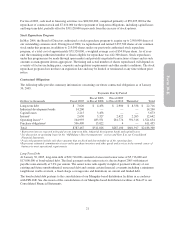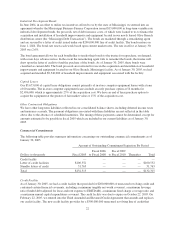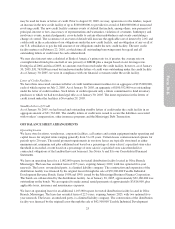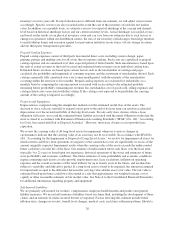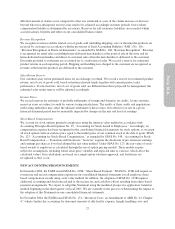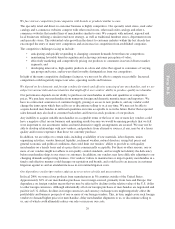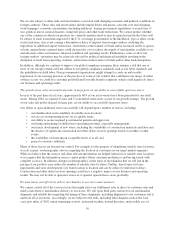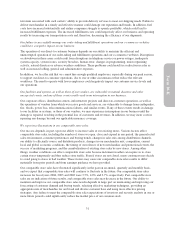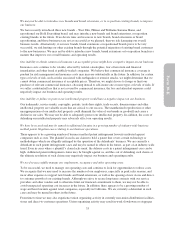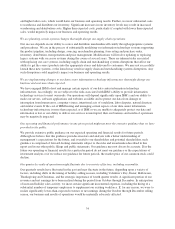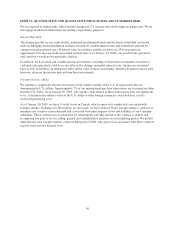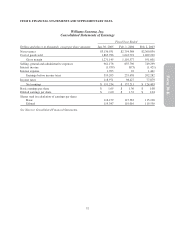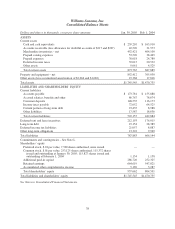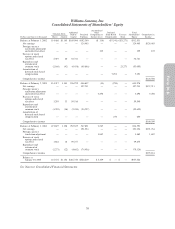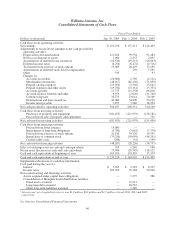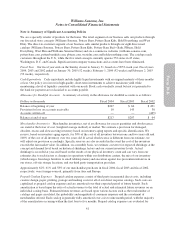Pottery Barn 2004 Annual Report Download - page 38
Download and view the complete annual report
Please find page 38 of the 2004 Pottery Barn annual report below. You can navigate through the pages in the report by either clicking on the pages listed below, or by using the keyword search tool below to find specific information within the annual report.
terrorism associated with such carriers’ ability to provide delivery services to meet our shipping needs. Failure to
deliver merchandise in a timely and effective manner could damage our reputation and brands. In addition, fuel
costs have increased substantially and airline companies struggle to operate profitably, which could lead to
increased fulfillment expenses. The increased fulfillment costs could negatively affect our business and operating
results by increasing our transportation costs and, therefore, decreasing the efficiency of our shipments.
Our failure to successfully manage our order-taking and fulfillment operations and our e-commerce websites
could have a negative impact on our business.
The operation of our direct-to-customer business depends on our ability to maintain the efficient and
uninterrupted operation of our order-taking and fulfillment operations and our e-commerce websites. Disruptions
or slowdowns in these areas could result from disruptions in telephone service or power outages, inadequate
system capacity, system issues, security breaches, human error, changes in programming, union organizing
activity, natural disasters or adverse weather conditions. These problems could result in a reduction in sales as
well as increased selling, general and administrative expenses.
In addition, we face the risk that we cannot hire enough qualified employees, especially during our peak season,
to support our direct-to-customer operations, due to war or other circumstances that reduce the relevant
workforce. The need to operate with fewer employees could negatively impact our customer service levels and
our operations.
Our facilities and systems, as well as those of our vendors, are vulnerable to natural disasters and other
unexpected events, and any of these events could result in an interruption in our business.
Our corporate offices, distribution centers, infrastructure projects and direct-to-customer operations, as well as
the operations of vendors from which we receive goods and services, are vulnerable to damage from earthquakes,
fire, floods, power loss, telecommunications failures, and similar events. If any of these events results in damage
to our facilities or systems, or those of our vendors, we may experience interruptions in our business until the
damage is repaired, resulting in the potential loss of customers and revenues. In addition, we may incur costs in
repairing any damage beyond our applicable insurance coverage.
We experience fluctuations in our comparable store sales.
Our success depends, in part, upon our ability to increase sales at our existing stores. Various factors affect
comparable store sales, including the number of stores we open, close and expand in any period, the general retail
sales environment, consumer preferences and buying trends, changes in sales mix among distribution channels,
our ability to efficiently source and distribute products, changes in our merchandise mix, competition, current
local and global economic conditions, the timing of our releases of new merchandise and promotional events, the
success of marketing programs, and the cannibalization of existing store sales by new stores. Among other
things, weather conditions can affect comparable store sales because inclement weather can require us to close
certain stores temporarily and thus reduce store traffic. Even if stores are not closed, many customers may decide
to avoid going to stores in bad weather. These factors may cause our comparable store sales results to differ
materially from prior periods and from earnings guidance we have provided.
Our comparable store sales have fluctuated significantly in the past on an annual, quarterly and monthly basis,
and we expect that comparable store sales will continue to fluctuate in the future. Our comparable store sales
increases for fiscal years 2004, 2003 and 2002 were 3.5%, 4.0% and 2.7%, respectively. Past comparable store
sales are no indication of future results, and comparable store sales may decrease in the future. Our ability to
maintain and improve our comparable store sales results depends in large part on maintaining and improving our
forecasting of customer demand and buying trends, selecting effective marketing techniques, providing an
appropriate mix of merchandise for our broad and diverse customer base and using more effective pricing
strategies. Any failure to meet the comparable store sales expectations of investors and security analysts in one or
more future periods could significantly reduce the market price of our common stock.
31
Form 10-K


